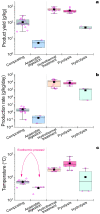Artificial Humic Substances as Biomimetics of Natural Analogues: Production, Characteristics and Preferences Regarding Their Use
- PMID: 38132553
- PMCID: PMC10742262
- DOI: 10.3390/biomimetics8080613
Artificial Humic Substances as Biomimetics of Natural Analogues: Production, Characteristics and Preferences Regarding Their Use
Abstract
Various processes designed for the humification (HF) of animal husbandry wastes, primarily bird droppings, reduce their volumes, solve environmental problems, and make it possible to obtain products with artificially formed humic substances (HSs) as analogues of natural HSs, usually extracted from fossil sources (coal and peat). This review studies the main characteristics of various biological and physicochemical methods of the HF of animal wastes (composting, anaerobic digestion, pyrolysis, hydrothermal carbonation, acid or alkaline hydrolysis, and subcritical water extraction). A comparative analysis of the HF rates and HS yields in these processes, the characteristics of the resulting artificial HSs (humification index, polymerization index, degree of aromaticity, etc.) was carried out. The main factors (additives, process conditions, waste pretreatment, etc.) that can increase the efficiency of HF and affect the properties of HSs are highlighted. Based on the results of chemical composition analysis, the main trends and preferences with regard to the use of HF products as complex biomimetics are discussed.
Keywords: anaerobic digestion; biosorbents; composting; hydrothermal carbonization; pyrolysis; waste treatment.
Conflict of interest statement
The authors declare no conflict of interest.
Figures



References
-
- Gerke J. Concepts and misconceptions of humic substances as the stable part of soil organic matter: A review. Agronomy. 2018;8:76. doi: 10.3390/agronomy8050076. - DOI
-
- Wang M., Li Y., Peng H., Wang J., Li Q., Li P., Fan J., Liu S., Zheng G. Review: Biotic and abiotic approaches to artificial humic acids production. Renew. Sustain. Energy Rev. 2023;187:113771. doi: 10.1016/j.rser.2023.113771. - DOI
-
- Chen Y., Inbar Y., Chefetz B., Hadar Y. Composting and recycling of organic wastes. In: Rosen D., Tel-Or E., Hadar Y., Chen Y., editors. Modern Agriculture and the Environment. Springer; Dordrecht, The Netherlands: 1997. p. 71. (Developments in Plant and Soil Sciences). - DOI
-
- Filho J.F.D.C.L., Thomason W.E., Evanylo G.K., Zhang X., Strickland M.S., Chim B.K., Diatta A.A. The synergistic effects of humic substances and biofertilizers on plant development and microbial activity: A review. Int. J. Plant Soil Sci. 2020;32:56–75. doi: 10.9734/ijpss/2020/v32i730306. - DOI
Publication types
Grants and funding
LinkOut - more resources
Full Text Sources
Research Materials
Miscellaneous

